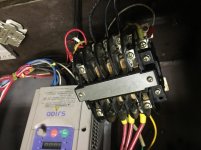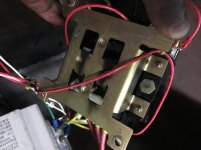wfrancis
Aluminum
- Joined
- Apr 18, 2012
- Location
- San Francisco, USA
After a year and half without my beloved 10EE due to living temporarily somewhere else then a shop move, I was thrilled when power was finally dropped today. It ran beautifully for several minutes until ... smoke, lots of smoke, then a muffled boom and everything died.
Upon investigation with my electrician it's believed the 3 phase leg which ran the 120V electromagnet for the contactor had the bad luck to get the stinger so it got 209V instead. At least those are the words he used and I believed him. The electromagnet is rather a nasty shade of melted now. I'm hoping the VFD itself is fine.
My lathe has what I believe to be an Al Sharon VFD conversion. I'm seeking help to find a replacement contactor of the same make/model as there are lots of wires coming off of it and if possible I'd rather do a straight swap. I couldn't find any writing on it but I am including photos and I hope someone will recognize. You can see the scorch marks on the backside view. Any leads appreciated.
The photos appear to be upside down in this post, though not upside down on my phone or computer. curious. Happy to send directly to anyone if that's helpful.



Upon investigation with my electrician it's believed the 3 phase leg which ran the 120V electromagnet for the contactor had the bad luck to get the stinger so it got 209V instead. At least those are the words he used and I believed him. The electromagnet is rather a nasty shade of melted now. I'm hoping the VFD itself is fine.
My lathe has what I believe to be an Al Sharon VFD conversion. I'm seeking help to find a replacement contactor of the same make/model as there are lots of wires coming off of it and if possible I'd rather do a straight swap. I couldn't find any writing on it but I am including photos and I hope someone will recognize. You can see the scorch marks on the backside view. Any leads appreciated.
The photos appear to be upside down in this post, though not upside down on my phone or computer. curious. Happy to send directly to anyone if that's helpful.






